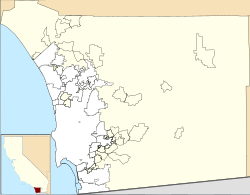Rancho Guajome Adobe is a historic 19th-century hacienda (and now a historic house museum) in Rancho Guajome Adobe County Park, on North Santa Fe Avenue in Vista, San Diego County, California. Built in 1852–53, it is a well-preserved but late example of Spanish-Mexican colonial architecture, and was designated a National Historic Landmark in 1970.[2] It is also a California Historical Landmark and on the National Register of Historic Places.
Rancho Guajome Adobe | |
 | |
| Location | Vista, Southern California |
|---|---|
| Coordinates | 33°13′59.59″N 117°15′14.42″W / 33.2332194°N 117.2540056°W |
| Area | 158 acres (64 ha) (landmarked area) |
| Built | 1852–1853 |
| Architectural style | Spanish—Mexican Colonial adobe |
| NRHP reference No. | 70000145 |
| Significant dates | |
| Added to NRHP | April 15, 1970[1] |
| Designated NHL | April 15, 1970[2] |
Description edit
Rancho Guajome Adobe is located in the northwestern part of Vista, on the south side of North Santa Fe Avenue. It is located just east of Guajome County Park, a larger park on the north side of the road. The adobe complex includes the main house, around which are arrayed a number of outbuildings. The main house is a large, rambling, 20-room, Spanish Colonial-style hacienda with two courtyards, and an arcaded veranda.[3] The arches on the veranda are not original to the house, however; they were added in the 1920s during the height of Mission and Spanish Colonial Revival architecture.[4] The outbuildings include stables, a blacksmith shop, chapel, and carriage house.[3]
History edit
The adobe was built in 1852 and served as the headquarters of Rancho Guajome, a Mexican land grant. Abel Stearns had given the rancho to Ysidora Bandini (sister of his wife Arcadia Bandini), as a wedding gift when she married Lieutenant Cave Johnson Couts in 1851. It was built with the profits from the cattle boom of the 1850s, when many California ranchos supplied the Gold Rush miners and associated new American immigrants with meat and leather.[5]
Couts was appointed sub-agent for the native Luiseño people (San Luis Rey Mission Indians) in 1853. He used their labor to improve his properties in the area, including this one and nearby Rancho Buena Vista and Rancho Vallecitos de San Marcos.[6][7]
Beginning in the 1970s, the county undertook a major rehabilitation of the property, which was completed in 1996. It is now the centerpiece of a county park 112 acres (45 ha) in size. Guided and self-guided tours are available, and the park facilities are available for special events.
See also edit
References edit
- ^ "National Register Information System". National Register of Historic Places. National Park Service. January 23, 2007.
- ^ a b "Guajome Ranch House". National Historic Landmark summary listing. National Park Service. Archived from the original on November 14, 2007. Retrieved November 18, 2007.
- ^ a b Patricia Heintzelman and Charles Snell (January 23, 1979). "National Register of Historic Places Inventory-Nomination: Guajome Ranchhouse" (pdf). National Park Service.
{{cite journal}}: Cite journal requires|journal=(help) and Accompanying 8 photos, exterior, from 1975 and undated. (2.37 MB) - ^ [1]
- ^ Historyandculture.com: Guajome adobe . accessed 9.6.2012
- ^ Slavery in the Golden State
- ^ Michael Magliari, 2004, Free Soil, Unfree Labor: Cave Johnson Couts and the Binding of Indian Workers in California, 1850-1867; August 2004; Pacific Historical Review
External links edit
- San Diego Parks - Rancho Guajome Adobe
- Historic American Buildings Survey (HABS) No. CA-43, "Casa de Rancho Guajome, San Luis Rey, San Diego County, CA", 14 photos, 12 measured drawings, 2 data pages, supplemental material


